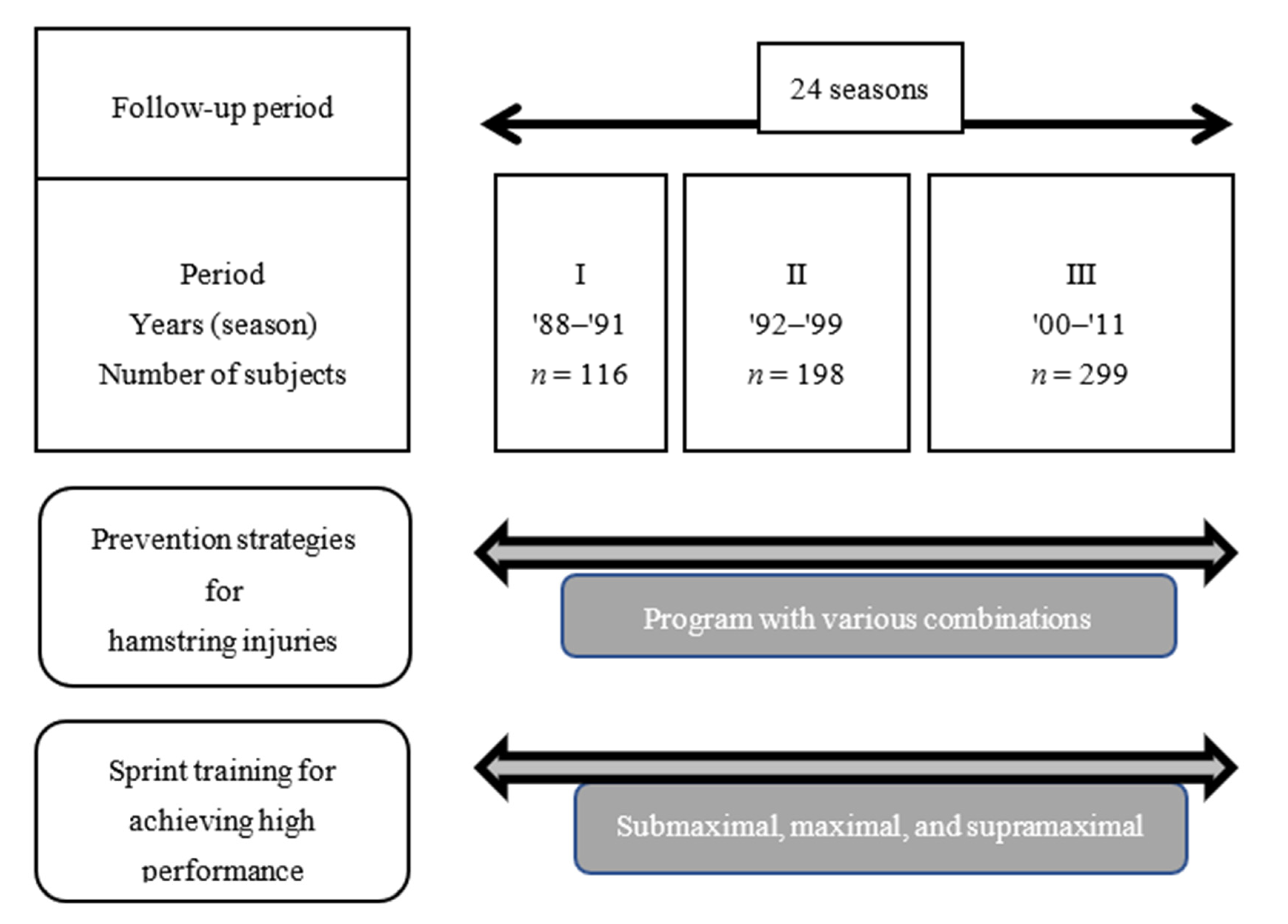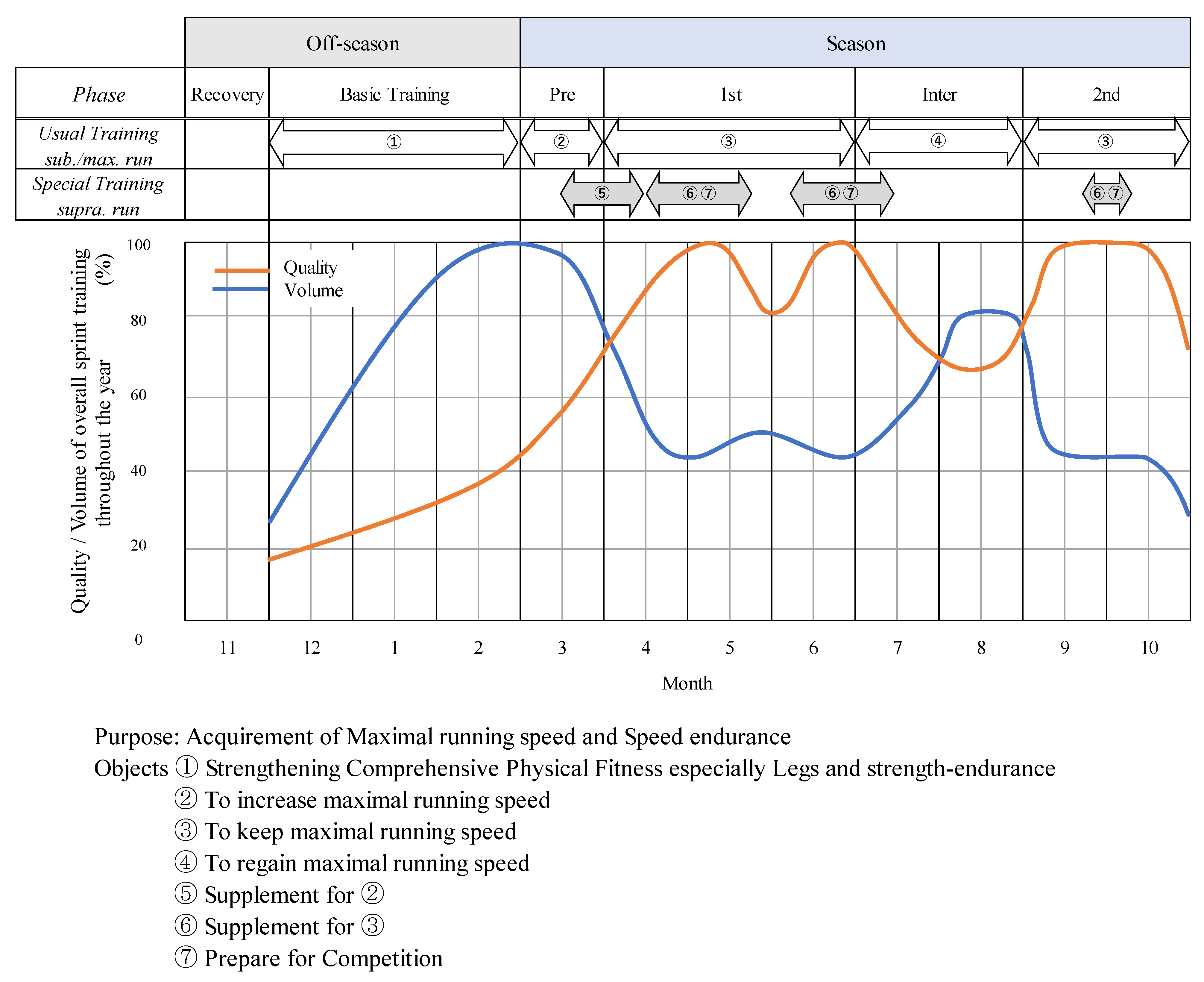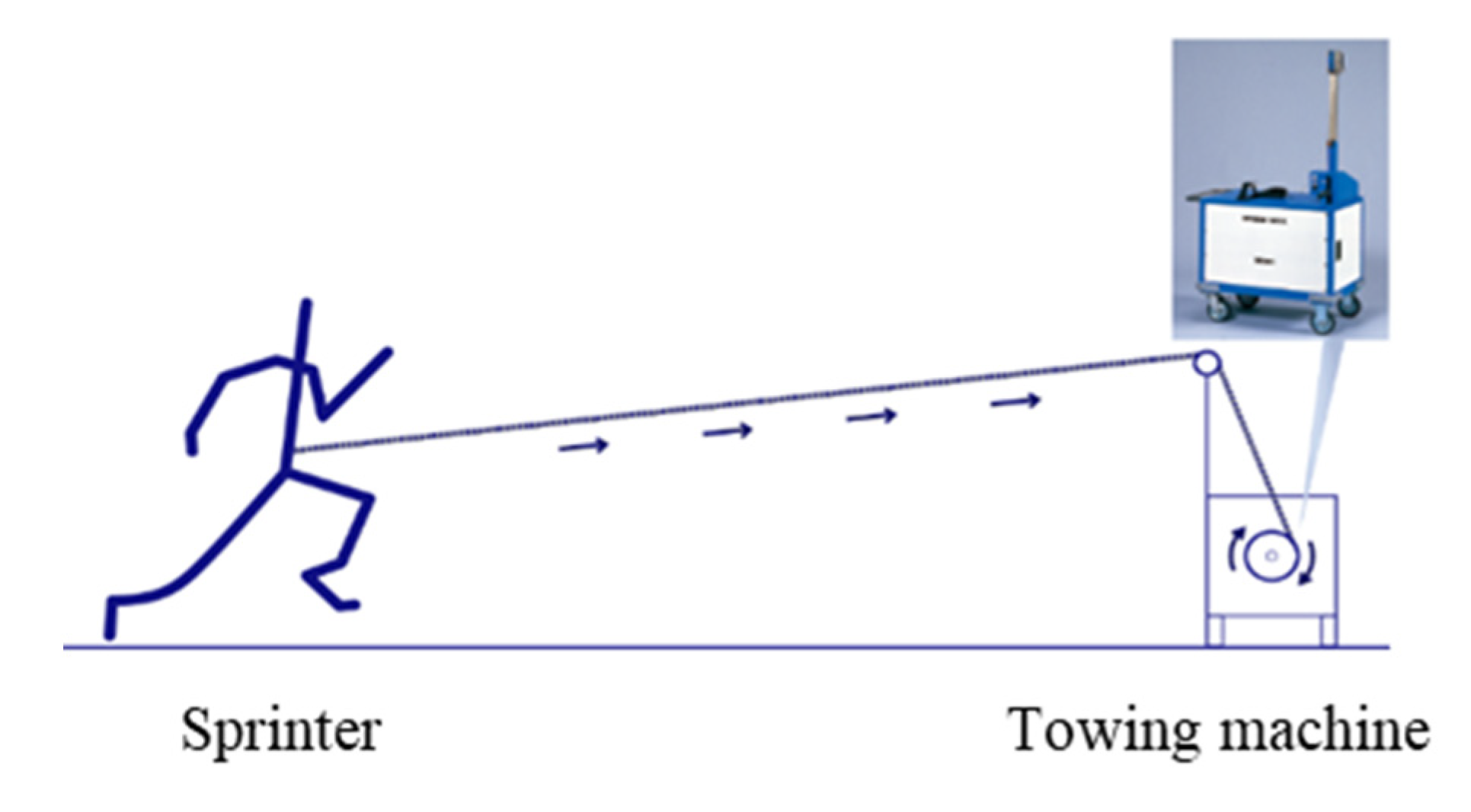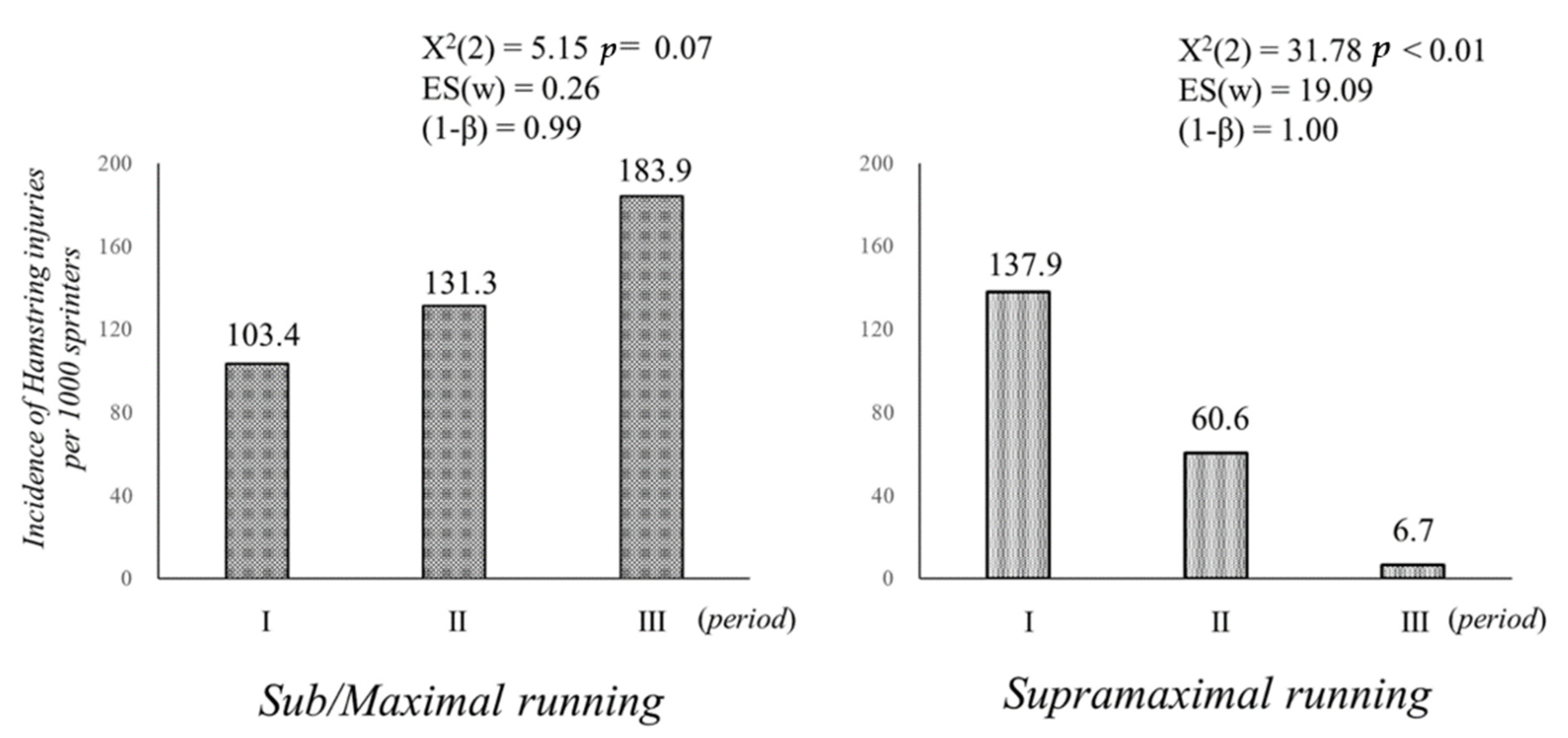Effects of Various Numbers of Runs on the Success of Hamstring Injury Prevention Program in Sprinters
Abstract
1. Introduction
2. Materials and Methods
2.1. Subjects
2.2. Study Design
2.3. Prescription for Quality/Volume of Overall Sprint Training throughout the Year
2.4. Submaximal and Maximal Running
2.5. Supramaximal Running
2.6. Hamstring Injury Prevention Program
2.7. Definition of Hamstring Injury
2.8. Statistical Analysis
2.9. Ethical Consideration
3. Results
4. Discussion
4.1. Consideration of the Methodology
4.2. Effects of the Combination of Prevention Program on the Number of Hamstring Injuries during Supramaximal Running
4.3. Effects of the Combination of Prevention Program on the Number of Hamstring Injuries during Submaximal and Maximal Running
4.4. Suggestions for Training
4.5. Limitation and Future Direction
5. Conclusions
Author Contributions
Funding
Institutional Review Board Statement
Informed Consent Statement
Data Availability Statement
Conflicts of Interest
References
- Arnason, A.; Andersen, T.E.; Holme, I.; Engebretsen, L.; Bahr, R. Prevention of hamstring strains in elite soccer: An intervention study. Scand. J. Med. Sci. Sports 2008, 18, 40–48. [Google Scholar] [CrossRef] [PubMed]
- Mjølsnes, R.; Arnason, A.; Østhagen, T.; Raastad, T.; Bahr, R.A. A 10-week randomized trial comparing eccentric vs. concentric hamstring strength training in well-trained soccer players. Scand. J. Med. Sci. Sports 2004, 14, 311–317. [Google Scholar] [CrossRef]
- Petersen, J.; Thorborg, K.; Nielsen, M.B.; Budtz-Jørgensen, E.; Hölmich, P. Preventive effect of eccentric training on acute hamstring injuries in men’s soccer: A cluster-randomized controlled Trial. Am. J. Sports Med. 2011, 39, 2296–2303. [Google Scholar] [CrossRef] [PubMed]
- Van der Horst, N.; Smits, D.W.; Petersen, J.; Goedhart, E.A.; Backx, F.J. The preventive effect of the nordic hamstring exercise on hamstring injuries in amateur soccer players: A randomized controlled trial. Am. J. Sports Med. 2015, 43, 1316–1323. [Google Scholar] [CrossRef] [PubMed]
- Verrall, G.M.; Slavotinek, J.P.; Barnes, P.G. The effect of sports special training on reducing the incidence of hamstring injuries in professional Australian rules football players. Br. J. Sports Med. 2005, 39, 363–368. [Google Scholar] [CrossRef]
- Sugiura, Y.; Sakuma, K.; Sakuraba, K.; Sato, Y. Prevention of hamstring injuries in collegiate sprinters. Orthop. J. Sports Med. 2017, 5, 2325967116681524. [Google Scholar] [CrossRef]
- Sugiura, Y.; Sakuma, K.; Fujita, S.; Sakuraba, K. Hamstring injury prevention program and recommendation for stride frequency during tow-training optimization. Appl. Sci. 2021, 11, 6500. [Google Scholar] [CrossRef]
- Devlin, L. Recurrent posterior thigh symptoms detrimental to performance in rugby union: Predisposing factors. Sports Med. 2000, 29, 273–287. [Google Scholar] [CrossRef] [PubMed]
- Worrell, T.W. Factors associated with hamstring injuries: An approach to treatment and preventative measures. Sports Med. 1994, 17, 338–345. [Google Scholar] [CrossRef] [PubMed]
- Agre, J.C. Hamstring injuries. Proposed aetiological factors, prevention, and treatment. Sports Med. 1985, 2, 21–33. [Google Scholar] [CrossRef] [PubMed]
- Petersen, J.; Hölmich, P. Evidence-based prevention of hamstring injuries in sport. Br. J. Sports Med. 2005, 39, 319–323. [Google Scholar] [CrossRef] [PubMed]
- Woods, C.; Hawkins, R.; Hulse, M.; Hodson, A. The football association medical research programme: An audit of injuries in professional football—Analysis of preseason injuries. Br. J. Sports Med. 2004, 38, 466–471. [Google Scholar] [CrossRef] [PubMed]
- Lieber, R.L.; Fridén, J. Selective damage of fast glycolytic muscle fibers with eccentric contraction of the rabbit tibialis anterior. Acta Physiol. Scand. 1988, 133, 587–588. [Google Scholar] [CrossRef] [PubMed]
- Hawkins, R.D.; Fuller, C.W. A prospective epidemiological study of injuries in four english professional football clubs. Br. J. Sports Med. 1999, 33, 196–203. [Google Scholar] [CrossRef]
- Dalton, S.L.; Kerr, Z.Y.; Dompier, T.P. Epidemiology of hamstring strains in 25 NCAA sports in the 2009–2010 to 2013–2014 academic years. Am. J. Sports Med. 2015, 43, 2671–2679. [Google Scholar] [CrossRef]
- Askling, C.M.; Tengvar, M.; Saartok, T.; Thorstensson, A. Acute first-time hamstring strains during high-speed running: A longitudinal study including clinical and magnetic resonance imaging findings. Am. J. Sports Med. 2007, 35, 197–206. [Google Scholar] [CrossRef]
- Ae, M.; Itoh, N.; Muraki, Y.; Miyashita, K. Optimal tension of isotonic towing for sprint training. In Proceedings of the XV Congress of International Society of Biomechanics, Jyvaskyla, Finland, 2–6 July 1995. [Google Scholar]
- Hicks, D. Resisted and assisted sprint training: Determining the transfer to maximal sprinting. New Stud. Athletics 2017, 32, 35–51. [Google Scholar]
- Huygaerts, S.; Cos, F.; Cohen, D.D.; Calleja-González, J.; Guitart, M.; Blazevich, A.J.; Alcaraz, P.E. Mechanisms of Hamstring Strain Injury: Interactions between Fatigue, Muscle Activation and Function. Sports 2020, 8, 65. [Google Scholar] [CrossRef]
- Wing, C.; Bishop, C. Hamstring strain injuries: Incidence, mechanisms, risk factors, and training recommendations. Strength Cond. J. 2020, 42, 40–57. [Google Scholar] [CrossRef]
- Sugiura, Y.; Aoki, J. Effects of supramaximal running on stride frequency and stride length in sprinters. Adv. Exerc. Sports Physiol. 2008, 14, 9–17. [Google Scholar]
- Sakuma, K. The comparison of two kinds of starting methods of baton receiver in 4 × 100 m relay. Juntendo Univ. Bull. Sch. Phys. Educ. 1984, 27, 105–111. [Google Scholar]
- Sakuma, K.; Sugiura, Y. Improving 4 × 100 meters relay performance. New Stud. Athletics 2017, 32, 83–93. [Google Scholar]
- Mero, A.; Komi, P.V. Effects of supuramaximal velocity on biomechanical variables in sprinting. J. Appl. Biomech. 1985, 1, 240–252. [Google Scholar]
- Clark, K.; Cahill, M.; Korfist, C.; Whitacre, T. Acute kinematic effects of sprinting with motorized assistance. J. Strength Cond. Res. 2021, 35, 1856–1864. [Google Scholar] [CrossRef] [PubMed]
- Corn, R.J.; Knudson, D. Effect of elastic-cord towing on the kinematics of the acceleration phase of sprinting. J. Strength Cond. Res. 2003, 17, 72–75. [Google Scholar] [CrossRef]
- Mero, A.; Komi, P.V.; Rusko, H.; Hirvonen, J. Neuromuscular and anaerobic performance of sprinters at maximal and supramaximal speed. Int. J. Sports Med. 1987, 8, 55–60. [Google Scholar] [CrossRef]
- Ito, N. Effects of towing system used a pulley on sprinting. Sprint Res. 1998, 8, 29–37. (In Japanese) [Google Scholar]
- Sugiura, Y.; Migita, T.; Sakuraba, K.; Sakuma, K.; Aoki, J. Effects of tow training on delayed-onset muscle soreness and serum CK activity for sprinters who are accustomed to supramaximal running. Jpn. J. Clin. Sports Med. 2009, 17, 247–254. (In Japanese) [Google Scholar]
- Mero, A.; Komi, P.V. Force-, EMG-, and elasticity-velocity relationships at submaximal, maximal and supramaximal running speeds in sprinters. Eur. J. Appl. Physiol. Occup. Physiol. 1986, 55, 553–561. [Google Scholar] [CrossRef]
- Dintiman, G.B. Training the sprinter. In What Research Tells the Coach about Sprinting; Cooper, J.M., Ed.; AAHPER Publications: Reston, VA, USA, 1974; pp. 49–81. [Google Scholar]
- Joyce, D.; Lewindon, D. Retraining the injured Athlete. In High-Performance Training for Sports; Joyce, D., Lewindon, D., Eds.; Human Kinetics Publishers: Champaign, IL, USA, 2014; pp. 85–96. [Google Scholar]
- de Vries, H.A. (Ed.) Flexibility. In Physiology of Exercise, 4th ed.; Brown Publishers: Cincinnati, OH, USA, 1986; pp. 461–472. [Google Scholar]
- Orchard, J.; Marsden, J.; Lord, S.; Garlick, D. Preseason Hamstring muscle weakness associated with hamstring muscle injury in Australian footballers. Am. J. Sports Med. 1997, 25, 81–85. [Google Scholar] [CrossRef]
- Brockett, C.L.; Morgan, D.L.; Proske, U. Predicting hamstring strain injury in elite athletes. Med. Sci. Sports Exerc. 2004, 36, 379–387. [Google Scholar] [CrossRef]
- Alonso, J.M.; Edouard, P.; Fischetto, G.; Adams, B.; Depiesse, F.; Mountjoy, M. Determination of future prevention strategies inelite track and field: Analysis of Daegu 2011 IAAF championships injuries and illnesses surveillance. Br. J. Sports Med. 2012, 46, 505–514. [Google Scholar] [CrossRef]
- Alonso, J.M.; Tscholl, P.M.; Engebretsen, L.; Mountjoy, M.; Dvorak, J.; Junge, A. Occurrence of injuries and illnesses during the 2009 IAAF World Athletics Championships. Br. J. Sports Med. 2010, 44, 1100–1105. [Google Scholar] [CrossRef] [PubMed]
- Junge, A.; Engebretsen, L.; Alonso, J.M.; Renström, P.; Mountjoy, M.; Aubry, M.; Dvorak, J. Injury surveillance in multi-sport events: The international olympic committee approach. Br. J. Sports Med. 2008, 42, 413–421. [Google Scholar] [CrossRef] [PubMed]
- Faul, F.; Erdfelder, E.; Lang, A.G.; Buchner, A. G*Power 3: A Flexible statistical power analysis program for the social, behavioral, and biomedical sciences. Behav. Res. Methods 2007, 39, 175–191. [Google Scholar] [CrossRef] [PubMed]
- Cohen, J. A power primer. Psychol. Bull. 1992, 112, 155–159. [Google Scholar] [CrossRef]
- Sugiura, Y.; Saito, T.; Sakuraba, K.; Sakuma, K.; Suzuki, E. Strength deficits identified with concentric action of the hip extensors and eccentric action of the hamstrings predispose to hamstring injury in elite sprinters. J. Orthop. Sports Phys. Ther. 2008, 38, 457–464. [Google Scholar] [CrossRef]
- Vasudevan, E.V.; Bastian, A.J. Sprit-belt treadmill adaptation shows different functional networks for fast and slow human walking. J. Neurophysiol. 2010, 103, 183–191. [Google Scholar] [CrossRef]
- Yamaguchi, T.; Ishii, K. An optimal protocol for dynamic stretching to improve explosive performance. J. Phys. Fit. Sports Med. 2014, 3, 121–129. [Google Scholar] [CrossRef]
- Papadopoulos, G.S.T.; Siatras, T.; Kellis, S. The effect of static and dynamic stretching exercises on the maximal isokinetic strength of the knee extensors and flexors. Isokinet. Exerc. Sci. 2005, 13, 285–291. [Google Scholar] [CrossRef]
- Rosenblett, B. Planning a performance programme. In High-Performance Training for Sports; Joyce, D., Lewindon, D., Eds.; Human Kinetics Publishers: Champaign, IL, USA, 2014; pp. 247–257. [Google Scholar]
- Small, K.; McNaughton, L.; Greig, M.; Lovell, R. The effects of multidirectional soccer-specific fatigue on markers of hamstring injury risk. J. Sci. Med. Sport 2010, 13, 120–125. [Google Scholar] [CrossRef]
- Greig, M. The influence of soccer-specific fatigue on peak isokinetic torque production of the knee flexors and extensors. Am. J. Sports Med. 2008, 36, 1403–1409. [Google Scholar] [CrossRef] [PubMed]
- Muyor, J.M.; Arrabal-Campos, F.M. Effects of acute fatigue of the hip flexor muscles on hamstring muscle extensibility. J. Hum. Kinet. 2016, 53, 23–31. [Google Scholar] [CrossRef] [PubMed][Green Version]
- Ito-Oonishi, S.; Takemura, M.; Kanamori, A.; Kusumoto, Y.; Miyakawa, S. Chronological changes in neuromuscular cooperativeness before and after muscle fatigue loading using the silent period of the quadriceps and hamstrings in young female athletes. J. Phys. Ther. Sci. 2021, 33, 908–911. [Google Scholar] [CrossRef] [PubMed]
- Baker, D. Recent trends in high-intensity aerobic training for field sports. Proof Strength Cond. 2011, 22, 3–8. [Google Scholar]
- Lord, C.; Ma’ayah, F.; Blazevich, A.J.A.J. Change in knee flexor torque after fatiguing exercise identifies previous hamstring injury in football players. Scand. J. Med. Sci. Sports 2018, 28, 1235–1243. [Google Scholar] [CrossRef] [PubMed]




| Basic Training: ① | Preseason: ② |
|
|
| 1st and 2nd Season: ③ | Interseason: ④ |
|
|
| Pre-Season and 1st Seasin: ⑤ | 1st, 2nd and Inter-Season: ⑥, ⑦ |
|
|
| Objective and Method | Action and/or Motion (Load) | Period | ||
|---|---|---|---|---|
| I | II | III | ||
| Strength | ||||
| Weight macine |
| ● | ● | ● |
| (3/5-4/5 of body weight × 10 repetitions × 3–5 sets) | ||||
| ● | ● | ||
| (4/5-5/5 of body weight × 10 repetitions × 3–5 sets) | ||||
| Body weight |
| ● | ||
| (lean forward slowly × 30–60 seconds × 5 sets) | ||||
| ● | |||
| (lean forward, downword, and upward × 10-20 repetitions × 5 sets) | ||||
| Agility | ||||
| Ladder |
| ● | ● | |
| (10 m × 4 repetitions) | ||||
| Mini-hurdle |
| ● | ● | |
| (10 hurdles × 4 repetitions) | ||||
| Flexibility | ||||
| Dynamic stretching |
| ● | ||
| (20 m × 1 repetitiion) | ||||
Publisher’s Note: MDPI stays neutral with regard to jurisdictional claims in published maps and institutional affiliations. |
© 2022 by the authors. Licensee MDPI, Basel, Switzerland. This article is an open access article distributed under the terms and conditions of the Creative Commons Attribution (CC BY) license (https://creativecommons.org/licenses/by/4.0/).
Share and Cite
Sugiura, Y.; Sakuma, K.; Fujita, S.; Aoki, K.; Takazawa, Y. Effects of Various Numbers of Runs on the Success of Hamstring Injury Prevention Program in Sprinters. Int. J. Environ. Res. Public Health 2022, 19, 9375. https://doi.org/10.3390/ijerph19159375
Sugiura Y, Sakuma K, Fujita S, Aoki K, Takazawa Y. Effects of Various Numbers of Runs on the Success of Hamstring Injury Prevention Program in Sprinters. International Journal of Environmental Research and Public Health. 2022; 19(15):9375. https://doi.org/10.3390/ijerph19159375
Chicago/Turabian StyleSugiura, Yusaku, Kazuhiko Sakuma, Shimpei Fujita, Kazuhiro Aoki, and Yuji Takazawa. 2022. "Effects of Various Numbers of Runs on the Success of Hamstring Injury Prevention Program in Sprinters" International Journal of Environmental Research and Public Health 19, no. 15: 9375. https://doi.org/10.3390/ijerph19159375
APA StyleSugiura, Y., Sakuma, K., Fujita, S., Aoki, K., & Takazawa, Y. (2022). Effects of Various Numbers of Runs on the Success of Hamstring Injury Prevention Program in Sprinters. International Journal of Environmental Research and Public Health, 19(15), 9375. https://doi.org/10.3390/ijerph19159375






